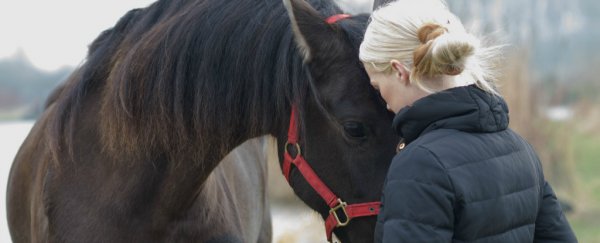Any horse lover can tell you that it often feels like our equine friends can read our minds. And now new research has shown that we might not just be imagining it - psychologists in the UK have found the first evidence that horses can distinguish between human facial expressions.
Not only that, but the animals also seem capable of finding meaning into our moods, with photos of angry faces setting their hearts racing, and causing them to look warily at the photos with their left eyes - something animals are known to do in response to negative stimuli.
Our understanding of how horses interact with humans is still in the very early stages, and this study only involved 28 horses, so we can't read too much into it just yet. But the finding suggests that we may have more ability to connect with these animals than previously assumed.
"What's really interesting about this research is that it shows that horses have the ability to read emotions across the species barrier," said lead researcher Amy Smith from the University of Sussex. "We have known for a long time that horses are a socially sophisticated species but this is the first time we have seen that they can distinguish between positive and negative human facial expressions."
To figure this out, the researchers took big, colour photos of the same man making two different facial expressions - either smiling happily and showing his teeth, or frowning and baring his teeth in anger.
They then had volunteers - who didn't know what photos they were holding, so as not to skew their body language - reveal these photos to 28 horses across five different stables in the UK. Despite not knowing the guy in the photos, the horses responded to his facial expressions very differently.
While they didn't seem too fussed when looking at the happy photo, as soon as they were shown the angry one, their heart rate increased and they started to show stress-related behaviours.
The horses also gave the photos the horse equivalent of the stink eye, moving their head so they looked at the angry faces only with their left eye.
That might sound weird, but research has shown that other animal species also look at negative things with their left eye, and the idea is that this is because it's the right brain hemisphere that processes threatening stimuli.
While we don't know exactly what the horses were thinking, the researchers conclude that, on some level, they were able to understand the relevance of the human faces they were seeing.
"It's interesting to note that the horses had a strong reaction to the negative expressions but less so to the positive," said Smith. "This may be because it is particularly important for animals to recognise threats in their environment. In this context, recognising angry faces may act as a warning system, allowing horses to anticipate negative human behaviour such as rough handling."
Dogs have also been shown to be able to recognise different human facial expressions, and, like horses, they tend to look at our negative faces with their left eye.
But this is the first time human expressions have been shown to directly affect another animal's heart rate, and it provides some insight into just how important the horse-human relationship has become over the millennia.
"There are several possible explanations for our findings. Horses may have adapted an ancestral ability for reading emotional cues in other horses to respond appropriately to human facial expressions during their co-evolution," said one of the researchers, Karen McComb. "Alternatively, individual horses may have learned to interpret human expressions during their own lifetime."
The research has been published in Biology Letters, and the team will now continue to study just how well horses really can read our strange, human faces.
In the meantime, please excuse me while I revisit all my childhood daydreams about living among a pack of wild horses, because they might have actually been able to understand me better than I imagined.
